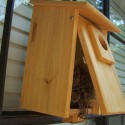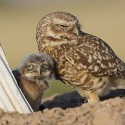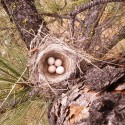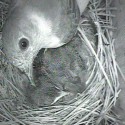 Photo ©
Keith Williams
Photo ©
Keith Williams

Should You Try a Window Nest Box?
Stick-on window-view nest boxes are the latest trend in birdhouses, but is this a trend that will really stick around? You may be wondering if a window-view nest box is a smart choice for the birds or for you. No long-term studies have been done on these products, but this spring NestWatch staff placed four different models on our own windows to find out if birds would use them. Below are the results of our limited field trial.
Three out of the four window nest boxes have stayed in place since the spring, plenty of time for a full nesting cycle or even two. Unfortunately, one box fell down about six weeks in, which would have been long enough for a bird to build a nest and lay eggs. It should be noted that the box which fell was the only one that did not have overhead cover.
As for nests, no birds have nested in any of our boxes to date. All are as clean as the day they were installed; not a single feather exists as evidence that they were even inspected. Both field testers have “traditional” nest boxes mounted around our properties which were used by House Wren, Carolina Wren, Black-capped Chickadee, Eastern Bluebird, Tree Swallow, and Downy Woodpecker (roosting only). Perhaps if these birds had no other options, they would have used the window boxes, but with other choices available, they did not.
Does our experience mean that these boxes aren’t appropriate? Not necessarily. Some birds, like people, are just bolder than others, and may take to the boxes right away. Cissy Berner reports that Carolina Wrens have used the nest box pictured above every year since 2013. Under certain circumstances, they may provide a needed cavity where no other options exist. For example, if you are noticing birds trying to nest in unsafe nooks, these boxes could provide alternative sites. But if you have the space, you can’t go wrong with a pole-mounted traditional box equipped with a predator guard. Alternatively, a hanging-style model works well in small spaces.
If you try it, choose a model that has the features of a good birdhouse, and follow the manufacturer’s instructions for mounting. Improper mounting can result in the box falling and possibly injuring birds, eggs, or even people. If you have experience with these boxes, good or bad, please tell us. Your diverse insights can only help us give better guidance in the future, and maybe even drive better product design.

Annual Photo Contest Is Underway
Our annual photography contest, Home Tweet Home, is underway. Submit up to four photos by July 31 for chances to win birdy prizes, like an HD nest-box camera, nest box, bird feeder, and swag from the Cornell Lab of Ornithology. You need not be a photographer to participate; visit the contest website and vote for your favorite photos. Share with your friends, and help determine the winners in each of the four categories: Beautiful Eggs, Best Nest, Cutest Baby, and Feeding Time. Winning entries will be announced in our August eNewsletter. Good luck to all of our Home Tweet Home contestants! See official rules for details.

Let’s Take a #Selfie
We love how new technology is so rapidly adopted by bird watchers to further their passions. High-def security cameras now watch over nesting birds, remotely-controlled drones monitor seabird colonies from the air, and inexpensive adapters turn smartphones into high-powered cameras. All of these new toys help us monitor birds while keeping a safe distance, but the latest and greatest “accessory” is one that has really split public opinion.
It’s called the “selfie stick,” a socially-provocative telescoping pole that remotely triggers your cell phone to take a picture of you and your friends (a.k.a., a “selfie”). Got a nest that is just out of reach? Selfie stick to the rescue! Snap a photo of the nest so you can count the eggs or nestlings. Some models can extend up to 32′ (10 m) and most allow for adjusting the angle of the camera. The devices use Bluetooth technology, or your camera’s timer, and work with a wide variety of smartphone models.
We credit this idea to Jeff Kozma, who is researching Gray Flycatchers in Washington. Jeff shared his photos with our Home Tweet Home contest, so you can see for yourself how it works. NestWatchers often ask how to report nests that are too high to see into, and the compact, portable selfie stick is one tool that can potentially help with this problem—no more taking a ladder into the field! And if anyone judges you for owning one, just tell them, “It’s for research.”

How To Report Nest Cam Data
Nest cams are increasingly becoming a tool in the NestWatcher’s toolbox. Many people want to know how to report their nest cams information to NestWatch. With an abundance of footage and known egg-laying, hatch, and fledge dates, the data quality can be very high. But how much is too much?
Just because you check your nest cams hourly doesn’t mean you need to report more than once a day. In fact, most nest-success analyses typically look at “daily survival rate” (which can then be extrapolated through the entire nest period). Increments of less than 24 hours are therefore not particularly needed.
Simply keep a NestWatch data sheet at hand to remind yourself to collect the minimum amount of information, so you don’t have to go back through all your footage (or your memory) later. Nest cams can be particularly useful for learning about under-studied species, such as owls. If you don’t yet have a nest box camera, but would like to learn more, check out our slideshow on installing a nest box camera.